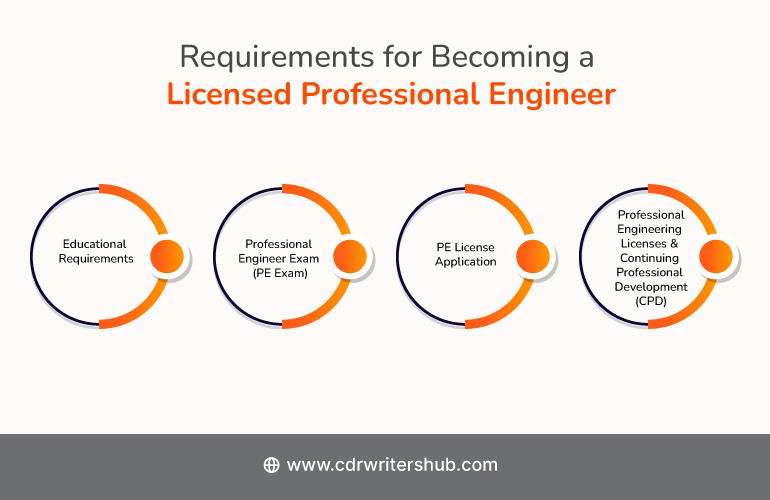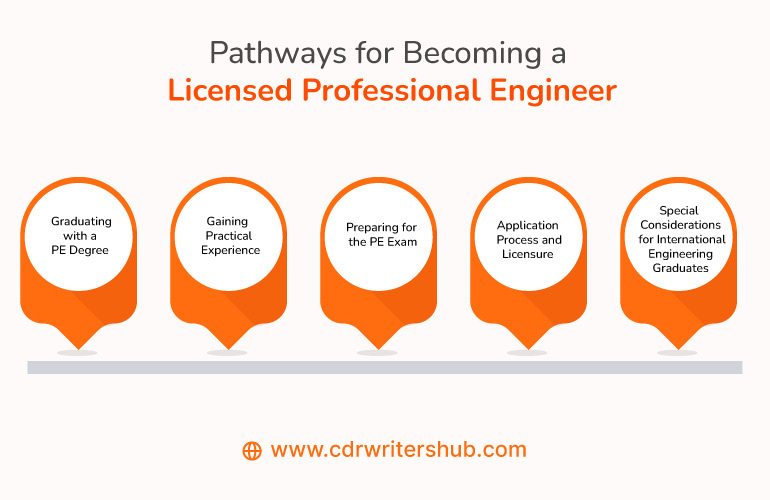How to become a Licensed Professional Engineer in Australia?

How to become a Licensed Professional Engineer in Australia?
Attaining permanent residency in Australia as a licensed Professional Engineer is a testament to obtaining a credential and showcasing an engineer’s competence, ethical conduct, and unwavering dedication to the engineering profession.
A licensed Professional Engineer holds the authority to design, oversee, and sign off on projects that impact public safety, infrastructure, and the environment. This authority underscores the immense responsibility of the title, emphasizing the need for rigorous education, practical experience, and adherence to ethical standards.
Join us as we unravel the steps leading you to earn the title of Professional Engineer and become an integral part of engineering. This blog is more than just a licensure process; it’s a gateway to a world of limitless possibilities, learning requirements, pathways of licensed professional engineers, and a legacy of impact.
What is a Professional Engineer License, and Why is it Important?
Table of Contents
At its core, a Professional Engineer license is a legal authorization that grants an engineer the authority to offer engineering services to the public. It is a mark of distinction that sets apart those who have demonstrated their competence, ethical conduct, and commitment to the engineering profession.
A PE license empowers engineers to design, oversee, and sign off on projects impacting public welfare, safety, and infrastructure. From designing sustainable buildings to crafting innovative solutions in transportation, energy, and beyond, licensed Professional Engineers are entrusted with shaping society’s fabric.
PE Exam
Understanding the structure, format, and content of the PE exam is crucial for adequate preparation. Engineers should familiarize themselves with the exam’s components, including the breadth and depth sections, to tailor their study plans accordingly.
PE Exam Resources and Study Materials
A comprehensive toolkit of study resources is essential for PE exam preparation. From reference materials and practice questions to mock exams and online resources, engineers have many tools to enhance their understanding and readiness for the exam.
Professional Engineering Exam
The Professional Engineer exam is a rigorous assessment that evaluates an engineer’s knowledge, expertise, and practical understanding of engineering principles. It is a critical step toward achieving PE licensure, and success in this exam is a testament to an engineer’s proficiency and readiness to undertake significant engineering responsibilities.
The Professional Engineering Examination evaluates an engineer’s proficiency across various subjects, from technical principles to ethical considerations. Understanding the scope and structure of the exam assists engineers in tailoring their preparation strategies and focusing on critical areas.
Becoming a PE Engineer
Becoming a licensed Professional Engineer is the culmination of dedication, preparation, and perseverance. Aspiring engineers can navigate the path to licensure by understanding the requirements, preparing meticulously, and embracing the challenges that lie ahead.
Becoming a Professional Engineer entails a comprehensive approach encompassing academic achievement, practical experience, and examination success. Engineers can confidently advance PE licensure by meticulously planning each step and leveraging available resources.
PE Exam Pass Rates
The pass rates of the PE exam offer beneficial insights into the challenges and triumphs of engineering aspirants. Analyzing these pass rates provides a glimpse into trends, study strategies, and focus areas that can significantly impact one’s chances of success. Understanding the nuances of PE exam pass rates helps aspirants tailor their preparation strategies and confidently approach the exam.
Requirements for Becoming a Licensed Professional Engineer
Licensing as a Professional Engineer (PE) requires meeting specific criteria of skilled professional to demonstrate your competence, expertise, and commitment to ethical engineering. This comprehensive guide outlines the requirements aspiring engineers must fulfill in pursuing PE licensure.
1. Educational Requirements
Educational requirements form the foundation for becoming a licensed Professional Engineer (PE). Candidates should complete a bachelor’s degree in engineering from an accredited institution. The educational program should comprehensively understand engineering principles, mathematics, sciences, and practical applications.
Courses in various engineering disciplines prepare candidates for the specialized knowledge required for their chosen field. Meeting educational prerequisites demonstrates a candidate’s commitment to academic excellence and lays the groundwork for further licensure steps.
2. Professional Engineer Exam (PE Exam)
The Professional Engineer exam plays a pivotal role in immigration trends to Australia, as it serves as a positive skills assessment that evaluates a candidate’s readiness to practice engineering independently.
It covers essential technical knowledge, problem-solving skills, and ethical considerations relevant to the candidate’s chosen discipline, aligning with the evolving demands of immigration and engineering practice in the country.
The PE exam is discipline-specific, focusing on the specialized engineering field the candidate intends to pursue. Successfully passing the PE exam is a significant milestone in the licensure process, indicating that the candidate possesses the expertise and competencies required for engineering practice.
3. PE License Application
The PE license application process involves submitting comprehensive documentation demonstrating a candidate’s qualifications and readiness for licensure. This application includes details about education, work experience, references from licensed Professional Engineers, and successful completion of the PE exam.
The application must be completed accurately and thoroughly, and candidates are often required to pay application fees. Some jurisdictions may also require candidates to undergo interviews or assessments as part of the application review process. Successfully navigating the application process showcases a candidate’s commitment to meeting the licensing authority’s standards and requirements.
4. Professional Engineering Licenses and Continuing Professional Development (CPD)
Once a candidate has obtained a PE license, the journey toward professional excellence continues through Continuing Professional Development (CPD). Licensed Professional Engineers are expected to engage in ongoing learning and skill enhancement to maintain their competence and stay current with advancements in the field.
CPD activities include attending workshops, conferences, seminars, and courses, participating in professional organizations, and contributing to research or publications. Following CPD requirements ensures that engineers remain at the forefront of their field and underscores their commitment to ethical and responsible engineering practice.
How Long Does It Take to Become a Licensed Professional Engineer?
The timeline to becoming a licensed Professional Engineer can vary based on individual circumstances, academic choices, and professional experiences. While the journey requires patience and persistence, the rewards of obtaining a PE license are immeasurable.
Role of a PE Degree in Your Licensure
A PE degree serves as the cornerstone of an engineer’s academic journey. It equips students with fundamental knowledge, analytical skills, and problem-solving abilities essential for success in engineering. While a PE degree is not the sole determinant of licensure, it lays a strong foundation for the challenges ahead.
Each state has its own set of requirements and regulations for licensed Professional Engineers. This diversity reflects the unique engineering landscape and priorities of each region. Engineers aspiring to obtain licensure should familiarize themselves with the specific requirements of their chosen state and tailor their preparations accordingly.
Journey to Professional Engineering Licensure
Becoming a licensed Professional Engineer is a transformative experience that molds individuals into capable, ethical, and proficient engineers. Navigating through education, experience, examination, and ethical considerations prepares engineers to embrace the responsibilities and privileges of a PE license.
-
Building a Solid Foundation
Adequate preparation for the Professional Engineering Exam requires a solid foundation of knowledge, a clear understanding of exam expectations, and a commitment to continuous learning. Engineers should approach their studies with diligence, curiosity, and a growth-oriented mindset.
-
Documentation, Fees, and Timelines
The application process for PE licensure involves a series of steps, from documenting education and experience to submitting the necessary fees. A complete understanding of the application requirements and a proactive approach to documentation ensure a smooth and successful application process.
Pathways for Becoming a Licensed Professional Engineer
Embarking on the journey to become a licensed Professional Engineer (PE) involves traversing multiple pathways, each contributing to your growth, knowledge, and readiness for the responsibilities that come with the coveted title.
Whether you’re a recent graduate, an experienced engineer, or an international engineering graduate, there are diverse routes to achieving PE licensure.
1. Graduating with a PE Degree:
For those pursuing an engineering degree, the path to becoming a licensed Professional Engineer begins with completing an accredited engineering program. A PE degree forms the cornerstone of your academic journey, equipping you with the foundational knowledge, technical skills, and problem-solving abilities essential for successful engineering practice.
As you progress through your PE degree program, you’ll have the opportunity to delve into various engineering disciplines, participate in hands-on projects, and collaborate with peers and mentors. These experiences enhance your understanding of engineering principles and lay the groundwork for the practical skills required in your future engineering career.
2. Gaining Practical Experience:
Beyond the classroom, practical experience is an indispensable aspect of your journey toward PE licensure. Engaging in internships, co-op programs, and entry-level engineering positions exposes you to real-world projects, challenges, and solutions. This hands-on experience allows you to apply theoretical knowledge, cultivate problem-solving skills, and develop a deeper appreciation for the complexities of engineering practice.
Supervised by experienced engineers, you’ll contribute to project design, analysis, and implementation, gradually building the competencies required of a licensed Professional Engineer. This phase of your journey fosters adaptability, teamwork, and effective communication – vital for successful engineering practice.
3. Preparing for the PE Exam
As you accumulate practical experience, the Professional Engineer exam looms on the horizon as a significant milestone on your licensure journey. Preparing for the PE exam requires a focused and systematic approach.
Familiarize yourself with the exam format, content specifications, and study resources available. Create a study plan that allocates sufficient time to review technical concepts, practice problem-solving, and simulate exam conditions through mock tests.
Remember that success in the PE exam requires technical expertise, effective time management, critical thinking, and the capability to apply your knowledge to real-world scenarios. Embrace a growth-oriented mindset and stay committed to continuous learning as you prepare for this positive skills assessment.
4. Application Process and Licensure:
Navigating the application process is the bridge that connects your academic achievements, practical experience, and exam success to the culmination of your journey – obtaining a Professional Engineer license. Research the specific requirements of your state or jurisdiction, compile the necessary documentation, and submit your application within the designated timeline.
The application process typically includes thoroughly reviewing your education, experience, and exam results. Depending on your jurisdiction, you may also undergo an interview or assessment to evaluate your readiness for licensure. Successfully meeting these requirements signals your readiness to join the ranks of licensed Professional Engineers.
5. Special Considerations for International Engineering Graduates:
For international engineering graduates seeking PE licensure in a new country, the journey may involve additional steps to align their qualifications with local standards. Many jurisdictions offer pathways to facilitate the recognition of overseas qualifications, enabling you to showcase your international engineering experience and knowledge.
Engaging in bridging programs, additional coursework, or assessments can help address gaps between your education and local requirements. These programs provide a platform to acquire the specific knowledge and skills needed to excel in the local engineering context and demonstrate your readiness for licensure.
Conclusion
Becoming a licensed professional engineer in Australia is a rewarding endeavor that demands dedication, commitment, and continuous learning. This guide has given you an in-depth understanding of the steps, requirements, and processes involved in achieving this milestone.
By following this comprehensive roadmap and leveraging your education and experience, you can embark on a successful engineering career in Australia that contributes to the nation’s growth and innovation.
CDRWritersHub serves as your dedicated ally, transforming your engineering journey into a persuasive CDR report that aligns with Engineers Australia’s standards and showcases your readiness to become a licensed Professional Engineer. With our expertise, your path to licensure in Australia is illuminated, ensuring your technical prowess and professional achievements shine brightly before assessors.




